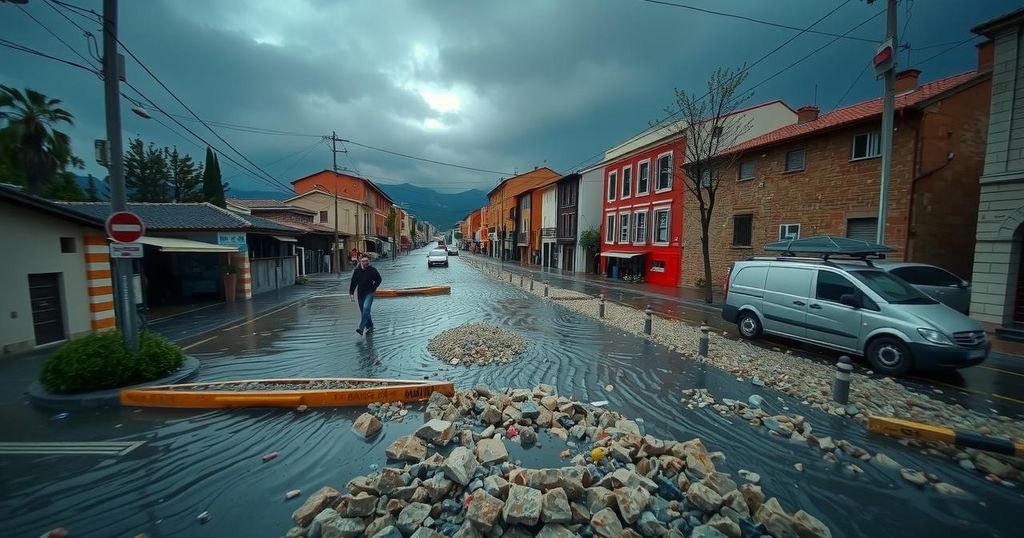Understanding the Catastrophic Floods in Eastern Spain: A Summary of Events and Implications
In eastern Spain, flash floods triggered by extraordinary rainfall have resulted in at least 158 fatalities, primarily in the Valencia region. The sudden floods overwhelmed communities, prompting ongoing recovery efforts obstructed by power outages and shortages. Climate change factors, such as warmer temperatures and jet stream fluctuations, have intensified such weather events, leading to this unprecedented natural disaster.
Recent flash flooding in eastern Spain has claimed the lives of at least 158 individuals, with the Valencia region being the hardest hit, recording 155 fatalities. The catastrophic event was precipitated by intense downpours that overwhelmed river basins, resulting in sudden torrents of water that caught many residents unprepared, leading to numerous tragic incidents. As emergency responders continue to search for missing persons, the recovery efforts are hampered by power outages and water shortages, compelling residents to confront the devastation and begin the arduous task of cleaning up their homes and surroundings. The extreme rainfall, described as astonishing by Spain’s national weather service, resulted in localities such as Chiva experiencing more precipitation in a mere eight hours than it had accumulated over the previous 20 months. This alarming weather phenomenon, often referred to in Spain as a DANA (an acronym for a weather system known as a cut-off lower pressure storm), was exacerbated by climate change. Scientists point to warmer atmospheric temperatures retaining more water vapor and shifts in the jet stream as contributing factors to the severity of such weather events. The Mediterranean Sea’s unusually high temperatures have also been a significant element triggering this alarming trend, marking the highest recorded surface temperature in mid-August at 28.47 degrees Celsius (83.25 degrees Fahrenheit). Experts have indicated that the cycle of droughts followed by severe flooding is set to continue as climate change intensifies these patterns. Historically, Spain’s coastal regions have experienced autumn storms, but the current flooding is unprecedented in terms of severity. Witness accounts suggest that the impacts of these recent floods have far surpassed historical severe weather events, with residents in affected areas recalling the 1957 floods, which were previously deemed the worst. This calamity surpasses previous natural disasters in Spain’s record, with the current event being the deadliest flooding event in living memory, surpassing the 1996 tragedy at the Gallego river. The recovery from this disaster will be a prolonged and challenging process as the nation grapples with the immediate aftermath and long-term implications of climate change.
The recent floods in eastern Spain represent a significant and tragic weather event exacerbated by climate change factors. Individuals in the affected areas were faced with rapid flooding that left many trapped and resulted in numerous fatalities. This occurrence aligns with an increasing trend in climate-related extreme weather patterns, where prolonged drought conditions alternate with severe flooding, leading to significant human and economic impacts. Historical context shows that while Spain is accustomed to seasonal storms, the intensity of this flooding marks a shift in the severity and frequency of natural disasters, reinforcing the vital need for enhanced climate preparedness and infrastructure resilience.
In summary, the unprecedented floods that struck eastern Spain serve as a stark reminder of the pressing challenges posed by climate change, showcasing the severe impact of extreme weather events. The rapid response and recovery efforts will be crucial in addressing the immediate needs of those affected while also emphasizing the urgent necessity for systemic changes to mitigate future risks related to climate disasters. The loss of life and widespread destruction highlight a critical moment for Spain and other nations to prioritize climate resilience and disaster preparedness.
Original Source: apnews.com




Post Comment